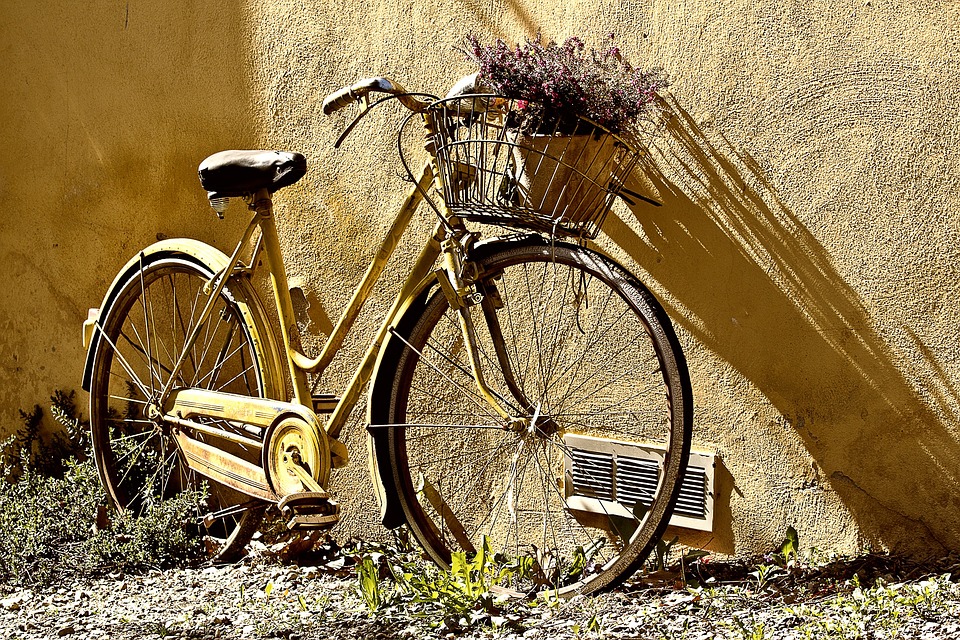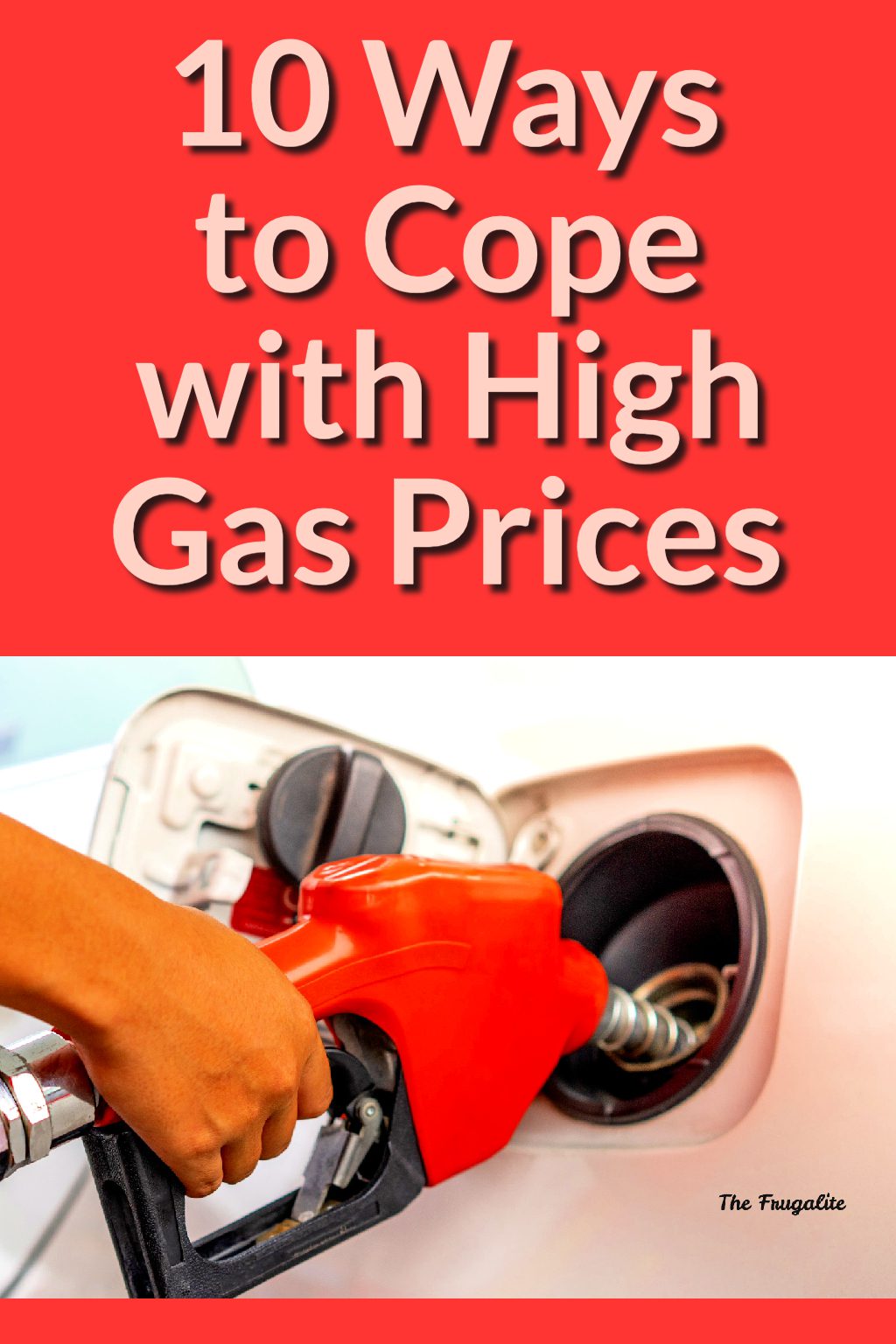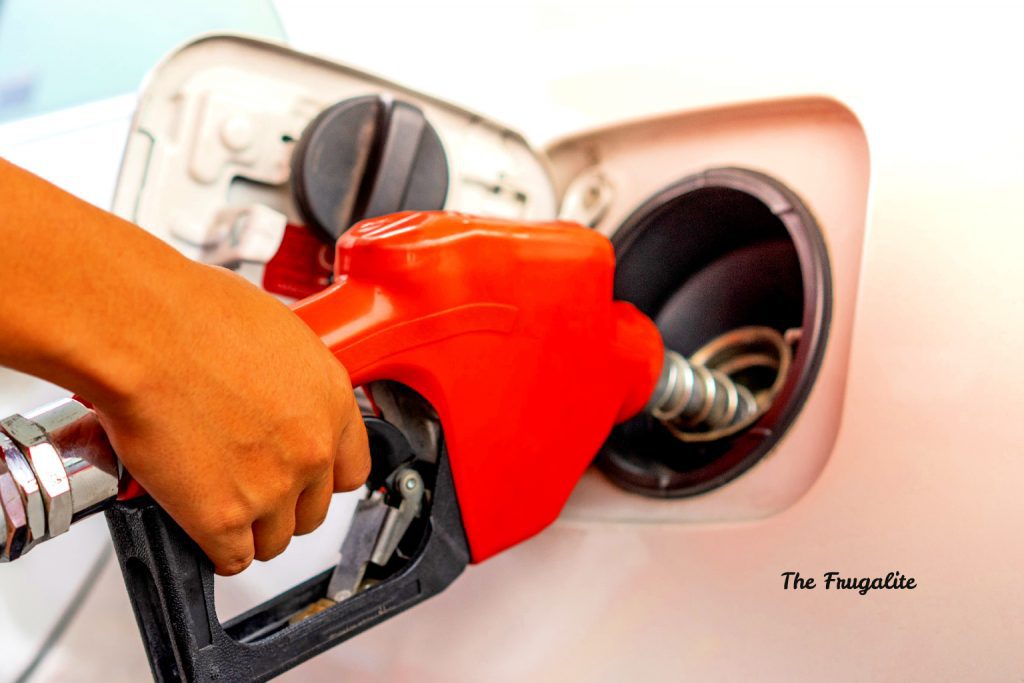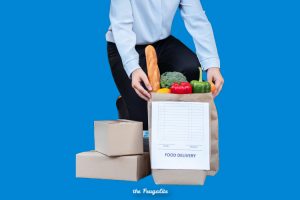(Psst: The FTC wants me to remind you that this website contains affiliate links. That means if you make a purchase from a link you click on, I might receive a small commission. This does not increase the price you’ll pay for that item nor does it decrease the awesomeness of the item. ~ Daisy)
By the author of The Ultimate Guide to Frugal Living and What to Eat When You’re Broke
Gas prices are certainly higher than I’ve ever seen here in the United States. Not only is the price of absolutely everything going up, but so is the price of going to get those things, as well as the price of going to work.
Below, find some suggestions that may help you to reduce your fuel expenses. Every suggestion won’t work for every person, but hopefully, you can piece a few of them together to save some money.
Walk more.
Do you live in a place where you can do some of your errands on foot? While a corner store is more expensive, if you have to drive half an hour to the grocery store, is it actually more expensive right now if all you need is a dozen eggs?
Explore your neighborhood on foot. Are there local shops or farms that you weren’t aware of? Is there a mailbox on the street you can use instead of going to the post office? If you live in a rural area, walking to do errands may not be possible, but in suburbia or urban areas, you may have better luck.
Get a bicycle.
This is another option for suburban or urban dwellers. You can cover a lot more mileage on a bicycle than you can on foot. When I checked out prices, I could get a brand new bicycle for the same price as two tanks of gas. This gives me a 5-10 mile radius instead of a 2-3 mile radius for errands.

Keep safety in mind if you’re bicycling. My city is set up for cyclists with bicycle lanes and bicycle paths. If yours is not, create routes that are designed for maximum safety. Don’t forget a helmet and a bike lock when choosing this option.
A backpack is the perfect choice for getting your goods back and forth.
Bundle your errands.
If walking and biking aren’t a possibility, then try bundling your errands. When you take the kids to swimming lessons, know which stores or destinations are nearby and go there while the children are in the water. Is there a grocery store near your workplace or the school? Shop on your way there or back.
Never run just a single errand if at all possible. I keep a running list on my refrigerator of things I need to do and group them accordingly.
Use public transportation.
Here’s another option for folks in more urban areas. Where I live, city buses have been free since the advent of Covid. Even if you have to pay bus fare, it’s going to be less expensive than driving in most cases.

Of course, taking public transit usually takes more time than driving yourself, but at this point, you’re either going to be spending time or money.
Work from home.
If you can work from home, you can save a lot of money on your commute. Not only do you save all that gas money, but you also save on a professional wardrobe, wear and tear on your vehicle, meals out, and many more expenses.
Add to this the extra time you’ll have by not spending hours in your vehicle.
Keep your vehicle maintained.
Keeping your vehicle well-maintained can help make it more efficient. Use fuel injector cleaner, make sure the tires are aired up to the proper inflation, and keep your oil changes current. Make sure to take care of evaporative leaks and replace your spark plugs as necessary.
Spend some money on making home a more desirable place to be.
While you don’t want to go overboard, spending a little bit of money to keep your family entertained and satisfied can go a long way toward keeping your car in the driveway instead of on the road.
One of the best purchases I ever made when my girls were younger was a trampoline. They spent hours on it every day for years. Other things might be a streaming service subscription, a wading pool, or outdoor games. Even something as small as sidewalk chalk can keep your kids busy.
To keep adults occupied, stock up on supplies for a favorite hobby or pastime.
Grow some food.
Any food you can produce yourself means you don’t have to drive to the store to get it. I live in an apartment building, but I have all the veggies I need for salad throughout summer growing on my patio. If you have a house with a yard, you can probably grow even more of your family’s produce.

Use what you have.
Start thinking about what you can use instead of what you “need” to get. Are you out of eggs? Maybe you have some common egg replacements on hand for baking, such as apple sauce, yogurt, or flaxseed meal. Out of pasta? Use rice instead or make homemade pasta.
Go further, though – it’s not just about food. Can you make your own body care products with pantry items? Can you re-read books that you haven’t read for a long time? Can you use the various yarns you have shoved in the back of your closet to make an afghan? Can you upcycle old clothes with your kids for a new fashion statement?
Out of plastic containers? Use jars from store-bought salsa or spaghetti sauce. Make use of the things you have before buying anything new – it keeps you off the road.
Adhere to a schedule.
One thing I’ve found really helpful is setting up a schedule. This helps me to bundle my errands, and it also helps me to know what day I’ll be going to certain parts of the city. Then I know that I can go to the pharmacy when I go to the post office on Thursdays, for example.
I shop on the same day each week, and I also do household chores on specific days. This keeps me organized and lets me know when I need certain supplies.
How do you cope with high gas prices?
Do you have any strategies for dealing with the skyrocketing prices of gasoline? Share them in the comments, and maybe you can help someone else save money.
About Daisy
Daisy Luther is a coffee-swigging, adventure-seeking, globe-trotting blogger. She is the founder and publisher of three websites. 1) The Organic Prepper, which is about current events, preparedness, self-reliance, and the pursuit of liberty; 2) The Frugalite, a website with thrifty tips and solutions to help people get a handle on their personal finances without feeling deprived; and 3) PreppersDailyNews.com, an aggregate site where you can find links to all the most important news for those who wish to be prepared. Her work is widely republished across alternative media and she has appeared in many interviews.
Daisy is the best-selling author of 5 traditionally published books, 12 self-published books, and runs a small digital publishing company with PDF guides, printables, and courses at SelfRelianceand Survival.com You can find her on Facebook, Pinterest, Gab, MeWe, Parler, Instagram, and Twitter.












12 thoughts on “10 Ways to Cope with High Gas Prices”
All the suggestions made in this article are what’s been done here. All are highly effective. When the cost of gasoline first rose majorly in 2008, instead of repairing my vehicle, it was parked and the bus became transportation + things are ordered online. Auto expenses aren’t missed and the budget covers emergencies a lot easier. As a student over 50 yrs ago, I rented near the univ. and walked everywhere. In the 1970s when there were long gas lines and we could only buy gas on ‘odd’ or ‘even’ days, I rode a bike. Prepare to change jobs OR move closer to your job. Take in borders/roommates. Find ways to make your budget stretch farther; there’s lots of good ideas on this website. Related: until or if the economy ‘stops’ due to lack of diesel fuel&related topics, buy enough to last upwards of 3 months or more.
We live in a small town where public transportation is not an option. We also don’t have a lot of shopping — two small local grocery stores that are more expensive than Walmart or a larger chain grocery (we have to drive over 70 miles round trip for those options), so we only shop there if we have to go for a doctor’s appointment (and I always keep a running list of what we need when we go). Even though the local stores are more expensive, the gas price makes more expensive to drive. My daughter and I also used to do a “girl’s trip” several times a year — just drive somewhere, shop, have lunch out and drive home. Those are a thing of the past. We also haven’t visited relatives who live in a city about 400 miles away for a long time nor have we taken a vacation. It is what it is — we simply can’t afford it. I shop very frugally — and only once a week on senior day. I bundle my errands — the auto insurance company actually questioned my mileage the last time I renewed. They give a low mileage discount and couldn’t believe I’d put so few miles on the car. I do buy some things that I can’t get locally on-line. We have cancelled cable and I’m searching for less expensive internet and cell phone providers. Fortunately, we don’t have a lot of medical or prescription expenses and we could walk to the pharmacy if we needed to. We do have a local doctor and only go out of town for specialist appointments. My daughter, who has disabilities, has a three-wheeled bicycle and could ride to the local grocery if necessary — I don’t let her because she has to cross busy streets to do so. I’m a bit (or a lot) past the age for riding a bicycle but have decided that I’m going to try her three-wheeled bike and see if I can work up to riding it to the store. We have also begun growing some basic vegetables on the railing of our deck and in large pots. Last year we got lots of green beans and one cucumber — this year it looks like we are going to be a bit more successful, unless hail or bugs get into things. I’ve also experimented some with re-growing vegetables like green onions, celery and lettuce. Had pretty good success but found they didn’t last for long. (They got mushy and rotted in the water — need to read up on that process more.) Right now, we are okay — but I think it is going to get worse and am trying to get things set up so we will continue to be okay!
Nan, if Lyin’ Biden gets reelected, things will DEFINITELY get worse!!!
A thought for you on re-growing green onions, those are the only ones I’ve done so I can at least give a few tips on them. The trick is to get the roots to grow in water then put them in dirt. However they don’t need much dirt, so you could have many green onions growing in one pot. Or even an old gallon water bottle with holes cut in the bottom. That has supplied me with all the green onions i need for quite some time now. When they flower you can save the seed. Maybe it only saves a few dollars but hey, fresh green onions are great!
With the skyrocketing gasoline prices, fuel thefts are making the news. It’s used to be that getting a locking gas cap was sufficient. Now there are stories of fuel thefts by drilling a hole in the gas tank and catching the spillage in some kind of container. That suggests a preference for either keeping your vehicle in a locked garage or parking in public places that a would-be thief would rather not risk — or even leaving a partner in the vehicle for very short in-and-out missions. Consider that the cost of getting an emergency tow plus the cost of a gas tank hole repair would not be cheap or convenient.
Regarding bicycles, a long time ago in grad school I learned that a metal toe loop on both bicycle foot pedals effectively doubles your pedaling efficiency. Without the toe loops you can only push downward with one leg at a time while the other merely rides upward. But with the toe loops in place, while one leg is pushing downward, the other can be pulling upward. This basically doubles the usefulness of your available pedaling muscles. Also make sure that each toe loop is a loose fit so in case of a possible fall you can quickly pull out your foot and foot-touch the ground to avoid a bad fall injury.
There are also shoe clips as an alternative to toe loops. I think there are such clips that attach to your shoes in ways so you can twist out of them quickly to avoid a nasty fall. See what’s available at your local bicycle shop.
Cross-country bicyclers have long used 2 and 4-wheel cargo trailers to enhance their load carrying capability. Frugal bicyclers have discovered that one and two-child carrying trailers from thrift stores can easily be converted into a dirt cheap cargo trailer — not only for their bicycle but also as a hiking trailer for walking. There are videos on YouTube (using the search phrase HIKING TRAILER) that demonstrate and discuss both retail and DIY hiking trailers. It’s rather amazing to find discussions from Europe
about using a hiking trailer most helpfully for cross-country thousand-plus kilometer hikes.
Even before the gas prices rise, realtors were using the term “walkability” to add value to houses within walking distance of your usual destinations — grocers, barbers, banks, post offices, and shipping and receiving services (to eliminate the porch pirate problem and handle packages via FedEx, DHL, UPS as well as USPS in contrast to USPS which won’t deal with its competition). Now that walkability factor means an even greater increase in value for whether you live in the house as an owner or use it as a rental.
Back to simple walking trips to the grocery. When that distance is reasonable for you and your state of health, there are several different folding luggage carts on Amazon that in combination with a large duffel bag or very large backpack can easily carry way more groceries than you’d want to carry on your shoulders. Another example is that every couple of years Aldi offers a $22 folding 2-wheel cart that’s rated to carry up to 150 pounds. That’s a lot of groceries that you can easily pull with just one hand with the load balanced over those two wheels.
–Lewis
We live about ten miles away from 3 small towns (2500-4000 population) in three different directions and about 25 miles from a larger college town of about 25,000 – but it has better shopping. My husband and I were discussing the thing cost of gasoline the other day. I remarked to him that it might be wise for neighbors to pitch in for fuel and ride with one person that has a larger vehicle, such as a large pickup or van and do grocery shopping. (And also other errands if possible. One might have a Dr or dentist visit, etc.) There is a small community about 5 miles from us with 2 gas station/convenience stores and a few houses and a post office. This seems like it would be a good place to set up a “farmers market” close by. It might even boost the sales of the convenience stores, the sale of drinks, snacks etc – plus both serve hamburgers, fries etc.
A win-win for both sides!
Years ago I began combining errands to save gas. I try to combine a trip to the bank with a trip to the grocery story and a trip to the drugstore with a trip to the craft store. Sometimes this means I have to choose carefully what stores I will visit. I may prefer the layout of one store but decide to go to a different one because I can combine another errand and still get the same store prices. This weekend I combined a trip to my bank with a planned trip to my church. The only adjustment I made was the time I went since both are very close together.
Our son pointed out something about the higher cost of going to the library. I didn’t like it, but I did the math and he was correct. The closest library is 10 miles away; the bigger one is about 16 miles. If I’m only going to get one particular book, that’s gasoline for 2 round trips. With the gas mileage our vehicle gets, it’s cheaper to order that book from ebay, if I can get it for $10 or less. It actually saves me money to buy the book. I’ve always enjoyed going to the library, but also, considering how physically difficult it is for me to go now, it just makes sense (most of the time) to order the book. And there are worse things than having my own copy of a book I like.
I hear you there! If you haven’t tried them, Thriftbooks sometimes has good deals too. Just wanted to give you another option to find good books. If you buy more than $10 at a time (combine book purchases) you can get free shipping. The deals aren’t always better but sometimes they are.
Yes, we also use Thriftbook, Abebooks and individual sellers on amazon. Never amazon themselves. The library that’s 16 miles away has a free shelf when I can leave books or get a couple for free. They used to leave it outside on a covered portico, but not anymore. It was a nice feature because their open hours aren’t very convenient.
Only one other thing I can think of is researching where the best prices are. I think gasbuddy.com still exists, and you can see if there are any surprise cheap prices near you.
History has some interesting examples of alternate fuels to avoid gasoline rip-offs or unavailability. I have a pre-1919 Ford Model-T radiator cap from that era when all Fords were multi-fuel capable. The owner or driver could switch between gasoline or alcohol (often locally or even self-made at home). The Rockefellers with their nationwide network of gasoline stations despised the occasional competition that alcohol made possible. So about 1914 they made a $4 million “donation” to the Women’s Christian Temperance Union to kick off a national campaign against the “immorality” of alcohol — which bore fruit when the Prohibition Amendment took effect during 1919.
That made the multi-fuel capability of Ford Model-Ts irrelevant except of course for gasoline only … so by 1933 most Fords on the road were made for gasoline only. The result was a Rockefeller heir in the summer of 1933 announcing to the New York media that Prohibition was no longer needed. So in December of 1933 Prohibition was officially ended, at least at the federal level. The government lie that Prohibition was all about, and only about, the immorality of boot-legging was even continued in a 1950s TV series called the Untouchables — a bit like lying to cover up the Rockefeller meningitis vaccine origin of the 1918 “Spanish Flu” that killed some 50 to 100 million people worldwide … including more Germans than WWI combat.
Another example of alternate fuels use for vehicles was during WWII when allied bombing took out much of the petroleum supply for Germany. The German back-up strategy was to convert some of their vehicle engines to run on bio-gas … made from various grains and greens grown in nature. These days the how-to of making bio-gas and converting engines to run on it is an easy look-up online.
The point of all this history is that if a combination of hyper-inflation and incredibly idiotic petroleum supply decisions from Washington, DC push the boundaries of gasoline and diesel affordability … there are technical alternative fuels possible if changing numbers make that feasible.
–Lewis